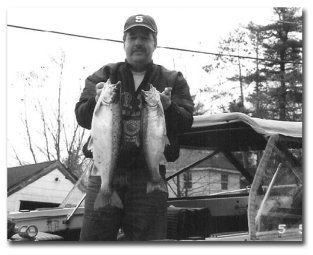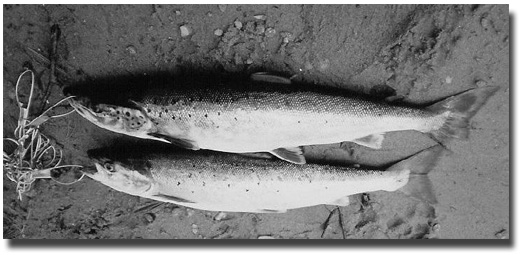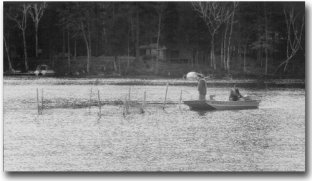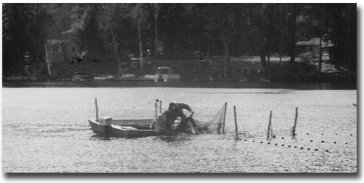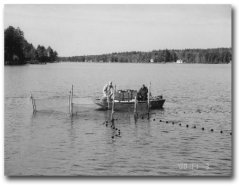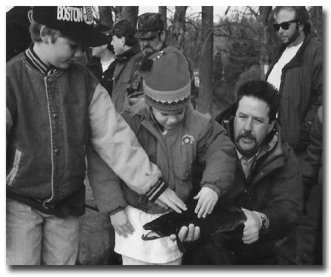|
[?]Subscribe To This Site
|
New Hampshire Fish and Game
|
| Month | Salmon (depth & lure) |
| May | 0-15 feet, Grey Ghost |
| June | 0-30 feet, Size 2 Needlefish White w/Pearl |
| July | 30-45 feet, Size 2, Needlefish White wi/Pearl |
| August | 30-45 feet, Size 2. Needlefish White w/Pearl |
| September | 0-45 feet, Size 1 Needlefish White w/Pearl |
Largest Salmon, Laker, Rainbow, bass and other fish you have caught?
Salmon:
Size: 25", 5.5 pounds in 1978
Lure: Red Ghost fly
Depth: on the surface
Laker:
Size: 25.5", 6.25 pounds in 1980
Lure: live smelt
Depth: 45 ft.
Other Large Fish (Lake Whitefish - Shad):
Size: 20", 4 pounds in 1978.
Lure: live smelt
Depth: 60 ft.
- Stories about these monsters?
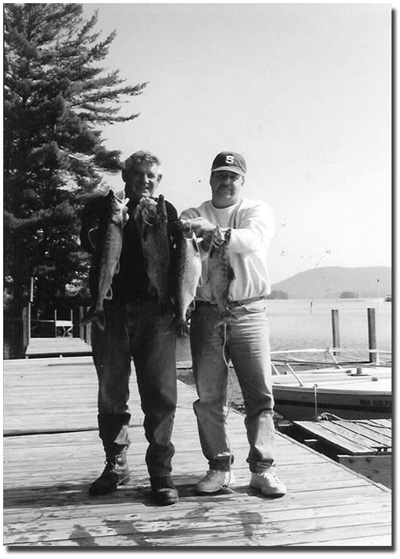
~ The salmon was caught early in the spring when I was trolling a small patch of open water near Governor’s Island Bridge. I was trolling a tandem Red Ghost with beads on a flat line and had just enough monofilament out that when I lifted the tip of my rod to the 12 o’clock position, the fly would break the water’s surface. After the fish hit I was having a pretty good battle with it though at that point it was a standoff.
The guy I was fishing with, who is a long-time friend, didn’t want to stop trolling because he’d seen several other salmon roll right around the boat. My friend kept urging me to hurry up and get the fish in the boat, and after a time I did, despite the fact that the boat was moving the whole time.
~ The lake trout was caught while I was ice fishing during the Meredith Rotary Club’s 1980 Fishing Derby. I had a bob house over an underwater hump that was located in about 50 feet of water between the south end of Rattlesnake and Ship Island.
The fish was caught on a tip-up baited with a live smelt. The lake trout was on the prize board until it got bumped off late Sunday, finishing 11th, while prize money was only being awarded for the top 10.
This particular location was very productive that winter and on many occasions when one flag went up 2 or 3 others would pop up simultaneously, as the lake trout moved over the hump in waves, apparently chasing schools of smelt.
~ The big lake white fish was caught on January 1, 1978 while I was ice fishing on Paugus Bay out in front of Christmas Island. The tip-up was set out where the old channel is located, being around 90 feet deep in that particular spot. The ice conditions that day were tenuous at best, as you could see the ice move up and down as you walked, although it was clear black ice.
I remember the ice conditions because we were having luck catching lake trout that morning and you could see them being brought to the surface when they were still 30 feet below the ice because the ice was so clear. Anyway, when the flag went up, I thought it was another lake trout until I saw it when it got to about 30 feet and it was light colored rather than dark.
Thinking it was a salmon I started getting prepared to cut the line. But when the fish was closer to the hole I saw it was a “shad,” so onto the ice it came. If I had known then that it was an unusually large lake whitefish I would have had it mounted rather than eating it that night for supper.
- Passing on to others your angling skills?
I have a son and daughter who spent many days fishing with me as they were growing up. Plus, I'm able to pass on my knowledge from working at the New Hampshire Fish and Game. They both continue to fish on occasion even though they are in their 20s. There are times my daughter will out-fish her boyfriend, who lives and breathes fishing.
- My top 5 tips for salmon?
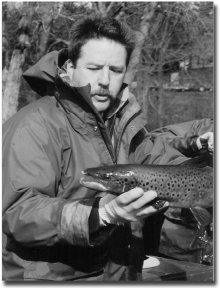
- Go early.
- Watch for surface activity.
- Find the schools of smelt.
- Match the size of your lure or fly to the most prevalent smelt size.
- Troll erratically.
- My top 5 tips for lakers?
- Go early.
- Fish deep or near deep under water structure.
- Troll as slowly as possible.
- Use big baits if you’re after big fish.
- Jigging works well whether you're ice fishing or fishing open water.
- My top 5 ice fishing tips?
- Go early.
- If you’re using tip-ups check the condition of your bait regularly.
- If you’re jigging, chum your hole with cut bait and add a piece of cut sucker to your jig hook.
- Cut big holes so you can get that big trout through it and onto the ice.
- Always, always, always check the ice conditions.
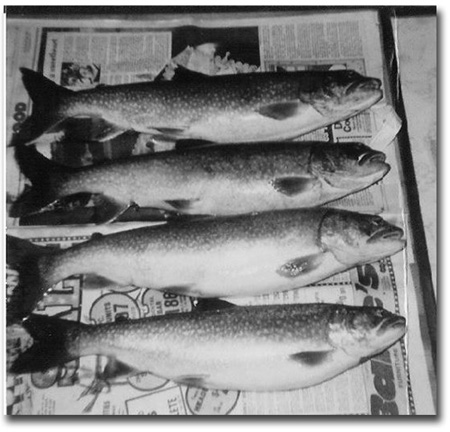
- Catch & release?
I practice catch and release most times. The only time I’ll keep a fish is if someone I know asks for one to eat, or the fish is injured to the point that it’s likelihood of survival is low. I practice catch and release primarily because the salmon and trout in Lake Winnipesaukee are a finite resource and are too valuable to be caught only once. My work at the New Hampshire Fish and Game has been carried over into my fishing methods on Lake Winnipesaukee and other surrounding lakes.
- What do I think has happened to the Lake Winni yellow perch?
With all the work I do at the New Hampshire Fish and Game,I think shoreline development has had a detrimental impact on the lake’s yellow perch. The proliferation of large-scale homes and condominium complexes with concurrent removal of trees, shrubs, and other natural vegetation along the lake’s shore, and installment of lawns right to the water's edge that get fertilized regularly, provides unregulated input of non-point source pollutants each time it rains. A variety of chemicals that are contained within lawn fertilizers can cause harm to fish and other aquatic organisms.
- What do I think has happened to the Lake Winni whitefish (“shad”)?
I don’t think anything dramatic has happened to the lake whitefish in the lake. Rather, I think the methods used to catch these fish during the yesteryears have been forgotten.
- If I were Commissioner of the New Hampshire Fish and Game, what, if any, initiatives would I take to improve Lake Winni angling?
As Commissioner of the New Hampshire Fish and Game, the primary initiative I would take is the restoration of a buffer zone along the shoreline so that water run-off is filtered prior to entering the lake. Another initiative would be developing a watershed scale plan for the lake so that issues affecting water quality could be identified and strategies adopted to mitigate adverse impacts.
- My philosophy, science, and specifics of how the New Hampshire Fish and Game Department controls the population of forage fish (smelt), which has such a close bearing on the health of the salmon populations. Is the present time the best for salmon size and numbers in Lake Winni? How delicate is the balance between the various fish populations?
The New Hampshire Fish and Game Department manages the lake’s smelt population by quantifying each year’s production of young-of-the-year smelt using a scientific quality echo sounder. The annual abundance estimate of smelt then forms the basis for adjusting the landlocked salmon stocking rate in an attempt to balance the predatory pressure landlocked salmon exert toward smelt with the smelt population’s ability to sustain that predatory pressure without being impacted significantly. This management strategy has stabilized salmon growth at an optimal rate.
Although salmon growth has been more consistent over the last decade, I don’t believe it has resulted in establishing “the best” time for salmon size and numbers. The average size of the salmon in the lake is more closely related to the age composition of the population. The older individual fish are in the lake, the larger the “average size” will be.
Angling pressure and harvest play a major role in the salmon population’s age composition. Currently, the New Hampshire Fish and Game has noted that fishing pressure is at a level that results in most salmon being harvested within a minimum of 2 years of reaching legal size (15 inches). Typically, in the fall of each year, 85% of the salmon population is age 2 and 3, while only 15% of the population is age 4 to age 6.
I believe this age structure is tied to the advent of down rigger fishing, which, from a practical manner, lengthened the active salmon fishing season on the lake. Prior to down riggers appearing on the scene, anglers fished for salmon primarily during April and May and maybe late September.
There were a few anglers that would fish for salmon when they went deep, using leadcore or wire line. With down riggers, more and more anglers fish for salmon during all months of the season, since fishing with light tackle, when the salmon are deep, makes it a more enjoyable experience than fishing with “heavy equipment”.
- Results of latest significant studies from the New Hampshire Fish and Game of various fish (salmon, lake trout, rainbows, and bass) in Lake Winni? What changes in game fish management did/do the results of these studies indicate and prompt?
- Salmon Study Results:
Salmon stocking rates influence salmon growth. Analysis of a long-term data set by the New Hampshire Fish and Game, determined a statistically significant negative relationship existed between the annual weight of yearling salmon stocked and the average size of the salmon captured by trap nets the following year.
What this means is when the total weight of yearling salmon stocked into Lake Winnipesaukee increased, the average size of salmon decreased the following year and conversely, when the total weight of salmon stocked decreased, the average size of salmon increased the following year.
This New Hampshire Fish and Game finding resulted in the establishment of a base-stocking rate for salmon (0.07 lbs./surface acre), which is intended to meet a management objective of maintaining an average size salmon, captured by trap nets during the fall, that ranges between 18 and 20 inches.
- Smelt Study Results:
Rainbow smelt populations fluctuate widely and the New Hampshire Fish and Game states that it is important to identify these fluctuations before salmon growth is affected. Quantifying the abundance of young-of-the year smelt on an annual basis, allows adjustments to be made to the base-stocking rate of yearling landlocked salmon, so that optimal growth of salmon can be maintained in conjunction with balancing predatory pressure being exerted by salmon on the lake’s smelt population.
The age structure of smelt spawning in tributaries to Lake Winnipesaukee is unusual since age 1 individuals dominate the run and typically smelt don’t become sexually mature until age 2. This may be due to the slower growth rates, resulting in age 1 smelt becoming sexually mature at this age rather than at age 2, and high predator based mortality rates. These New Hampshire Fish and Game findings further support the need to balance predator abundance with prey abundance.
- Lake Trout Study Results:
The increase in lake trout minimum length (from 15 inches to 18 inches) resulted in the New Hampshire Fish and Game protection of first time spawning lake trout in Lake Winnipesaukee. This is important since natural reproduction is being relied on to sustain the lake trout population.
- The New Hampshire Fish and Game introduction of rainbow trout (years and numbers stocked) and the prevalent theories as to why this did not create too much competition for salmon for forage fish.
Rainbow trout were first stocked directly into Lake Winnipesaukee during 1990 and have been stocked with 10,000-15,000 yearlings per year since that initial introduction.
The principal reason behind the New Hampshire Fish and Game initiating the stocking of rainbow trout into the State’s large lakes (>1,000 acres) was to provide winter anglers an alternative trout fishery that would take some of the angling pressure off lake trout during the ice-fishing season.
Rainbow trout were selected for stocking in these waters because of their propensity to forage on whatever prey item was most prevalent or available, while also maintaining consistent rates of growth regardless of what they are feeding on.
Additionally, rainbow trout will inhabit relatively shallow water during the winter months, particularly in areas where water is flowing into the lake, so winter anglers’ fish for rainbow trout in different locations than when they’re fishing for lake trout.
Lastly, the numbers of rainbow trout that the New Hampshire Fish and Game stocked into the lakes are kept at relatively low levels in an effort to reduce any negative affects they may have on the lake’s salmon population.
- What is the biggest rainbow, salmon, and laker found in my netting operations?
Biggest rainbow trout: 25 inches, 7.25 lbs.
Biggest salmon: 29.5 inches, 9.5 lbs.
Biggest lake trout: 35.6 inches, 14.6 lbs.
- New Hampshire Fish and Game annual census methods and objectives in Lake Winni (seining in rivers, at 2 Mile Island, annual high tech electronic scanning operations).
- Spring Smelt Assessment:
The objectives of this annual assessment are to determine size, age, and sex ratio characteristics of smelt spawning in tributaries. Comparison of these estimates through time provides information to the New Hampshire Fish and Game on the status of these spawning populations.
Samples of spawning smelt are obtained from selected tributaries with sampling occurring between 2100 and 2400 hours. Smelt are collected using a long handled (2.4-m) dip net (38-cm diameter) with 9-mm wire mesh. A minimum of 100 smelt is netted from each tributary and total length (mm), weight (g) and sex are recorded for each fish processed.
A sub-sample of up to 5 fish per 10mm length interval are kept in separate containers in order to obtain representative samples for age determinations.
- Summer Smelt Assessment:
To improve landlocked salmon management practices, the New Hampshire Fish and Game Department annually conducts acoustic surveys with the objectives to:
- Estimate the annual abundance of pelagic forage fish;
- Determine the species composition, size characteristics, and spatial distributions of pelagic forage fish;
- Estimate the annual abundance of juvenile rainbow smelt; and,
- Adjust landlocked salmon stocking rates to provide consistent growth.
Mobile hydroacoustic surveys are conducted by the New Hampshire Fish and Game during late-July and August when lakes are thermally stratified and rainbow smelt were restricted to the hypolimnion. Surveys are conducted at night, when limnetic fish tend to be more evenly dispersed, making acoustic quantification easier and more accurate.
- Landlocked Salmon Assessment:
The primary objectives of this annual assessment are to evaluate the age and growth characteristics of adult landlocked salmon in New Hampshire lakes. Adult landlocked salmon are sampled with trap nets set during the fall spawning season.
Representative samples of the landlocked salmon catch by the New Hampshire Fish and Game are sexed, measured for total length (mm), weighed, and examined for excised fins to determine their age, since each landlocked salmon cohort is marked by excising different fins prior to their release as juveniles.
- Lake Trout Assessment:
The New Hampshire Fish and Game objectives of lake trout assessments are to evaluate spawning lake trout in terms of mean length, weight, and relative weight and to compare these statistics to long-term data sets. Lake trout are sampled by both small mesh gill nets and trap nets in the fall of the year.
All captured lake trout are measured for total length (mm), weighed, and sexed and then are released at the site of capture. Relative weight values are derived as a measure of fish condition. This index compares the actual weight of an individual with a standard weight for a fish of the same length.
- Am I concerned about mercury levels in Lake Winni fish to the degree that I restrict my fish intake?
No.To order the complete award-winning book, Angling in the Smile of the Great Spirit, or its accompanying DVDs featuring live interviews with the Master Anglers of Lake Winni, please go to: www.deepwaterspress.com






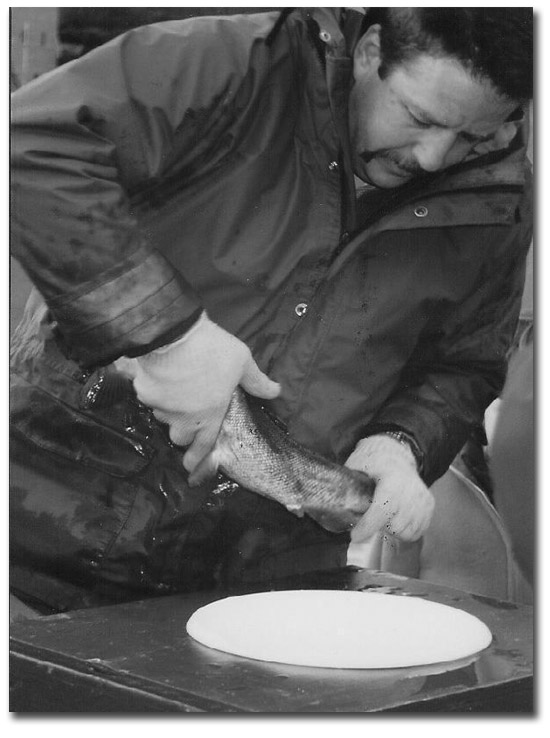 I first met Steve Perry 9 years ago, once attracted to his writings and studies on Game Fish in New Hampshire and Lake Winni. He is a scientific outdoorsmen, having had the good fortune to make his career be about what he most loves - angling.
I first met Steve Perry 9 years ago, once attracted to his writings and studies on Game Fish in New Hampshire and Lake Winni. He is a scientific outdoorsmen, having had the good fortune to make his career be about what he most loves - angling. 